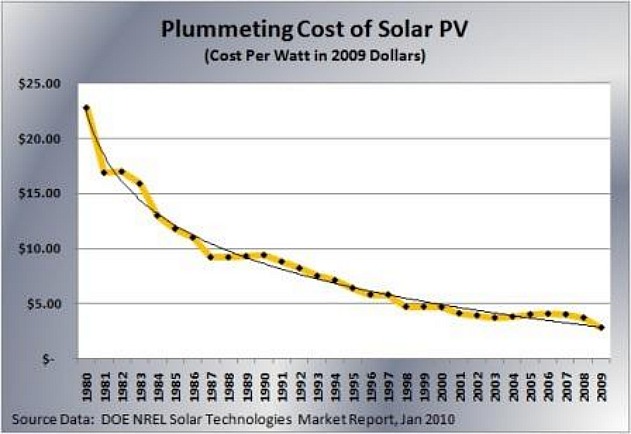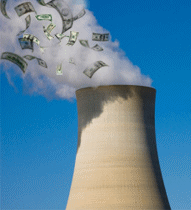We’ve known for a while that the cost of new nuclear power plants in this country has been soaring.
Before 2007, price estimates of $4,000 per kilowatt for new U.S. nukes were common, but by Oct. 2007, Moody’s Investors Service report, “New Nuclear Generation in the United States,” concluded, “Moody’s believes the all-in cost of a nuclear generating facility could come in at between $5,000 to 6,000 per kilowatt.” That same month, Florida Power and Light, “a leader in nuclear power generation,” presented its detailed cost estimate for new nukes to the Florida Public Service Commission. It concluded that two units totaling 2,200 megawatts would cost from $5,500 to $8,100 per kilowatt — $12 billion to $18 billion total! In 2008, Progress Energy informed state regulators that the twin 1,100-megawatt plants it intended to build in Florida would cost $14 billion, which “triples estimates the utility offered little more than a year ago.” That would be more than $6,400 a kilowatt. (And that didn’t even count the 200-mile $3 billion transmission system utility needs, which would bring the price up to a staggering $7,700 a kilowatt.)
Historical data cost on the French nukes have not been as well publicized. But Arnulf Grubler of the International Institute for Applied Systems in Austria, using “largely unknown public records,” was able to perform an analysis of French (and U.S.) nuclear plants for Energy Policy, “The costs of the French nuclear scale-up: A case of negative learning by doing” [$ubreq]:
Drawing on largely unknown public records, the paper reveals for the first time both absolute as well as yearly and specific reactor costs and their evolution over time. Its most significant finding is that even this most successful nuclear scale-up was characterized by a substantial escalation of real-term construction costs.
 Average and min/max reactor construction costs per year of completion date for U.S. and France versus cumulative capacity completed.
Average and min/max reactor construction costs per year of completion date for U.S. and France versus cumulative capacity completed.
Before discussing that paper, it is worth noting that renewable energy technologies have classic learning curves. Here is solar:

Wind power looks similar.
While Grubler’s Energy Policy paper is behind a firewall, his original IIAS interim report, “An assessment of the costs of the French nuclear PWR program, 1979-2000,” is online here.
Grubler explains the reasons for the overall “success” of the French program, at least in terms of scale:
The ambitious French PWR expansion program is legitimately considered the most successful scaling-up of a complex, largescale technology in the recent history of industrialized countries. This paper has argued that above all, the reasons for this success lay in a unique institutional setting allowing centralized decisionmaking, regulatory stability, dedicated efforts for standardized reactor designs (which could long profit from knowledge spillovers via the Westinghouse license), and a powerful nationalized utility, E´ DF, whose substantial in-house engineering resources enabled it to act as principal and agent of reactor construction simultaneously.
He then explores the implications of the cost escalation, the “negative learning”:
Despite a most favorable setting, the French PWR program exhibited substantial real cost escalation …
… despite more moderate cost escalation [than the U.S.], the French experience nonetheless raises a number of fundamental issues worth considering in a climate-constrained world …
First, while the nuclear industry is often quick to point at public opposition and regulatory uncertainty as reasons for real cost escalation, it may be more productive to start asking whether these trends are not intrinsic to the very nature of the technology itself: large-scale, lumpy, and requiring a formidable ability to manage complexity in both construction and operation. These intrinsic characteristics of the technology limit essentially all classical mechanisms of cost improvements-standardization, large series, and a large number of quasi-identical experiences that can lead to technological learning and ultimate cost reductions — except one: increases in unit size, i.e., economies of scale. In the history of steam electricity generation, these indeed led initially to substantial cost reductions, but after the late 1960s that option has failed invariably due to continued design changes (leading to higher material requirements per kilowatt — the current EPR design being the most “heavy”) and also increases in technological complexity.
As Richard Caperton and I wrote for CNN, new reactors are intrinsically expensive because they must be able to withstand virtually any risk that we can imagine, including human error and major disasters. Why? Because when the potential result of a disaster is the poisoning — and ultimately, death — of thousands of people, even the most remote threats must be eliminated.
Lastly, the French nuclear case has also demonstrated the limits of the learning paradigm: the assumption that costs invariably decrease with accumulated technology deployment. The French example serves as a useful reminder of the limits of the generalizability of simplistic learning/experience curve models. Not only do nuclear reactors across all countries with significant programs invariably exhibit negative learning, i.e., cost increase rather than decline, but the pattern is also quite variable, defying approximations by simple learning-curve models, as shown in Fig. 13 [reprinted above].
Why did the costs escalate? Why was there “negative learning?” He offers this theory:
… with increasing application (“doing”), the complexity of the technology inevitably increases leading to inherent cost escalation trends that limit or reverse “learning” (cost reduction) possibilities. In other words, technology scale-up can lead to an inevitable increase in systems complexity (in the case of nuclear, full fuel cycle management, load-following operation mode, and increasing safety standards as operation experience [and unanticipated problems] are accumulating) that translates into real-cost escalation, or “negative learning” in the terminology of learning/ experience curve models. The result may be a much wider cost variation across different technologies than so far anticipated.
That seems unlikely to change any time soon given recent events in Japan.
In fact, the cost of new nuclear power plants has continued to escalate in the United States, France, and other countries since 2000:
- French nuclear giant “Areva has acknowledged that the cost of a new reactor today would be as much as 6 billion euros, or $8 billion, double the price offered to the Finns.” (May ’09)
- Toshiba tells San Antonio its new twin $13 billion nukes will cost $4 billion more. The city balks. (Oct. ’09)
- Nuclear bombshell: $26 Billion cost — $10,800 per kilowatt! — killed Ontario nuclear bid. (July ’09)
Indeed, the Toronto Star published these stunning details in Canada’s largest daily newspaper about Areva’s Ontario bid:
AECL’s $26 billion bid was based on the construction of two 1,200-megawatt Advanced Candu Reactors, working out to $10,800 per kilowatt of power capacity …
The bid from France’s Areva NP also blew past expectations, sources said. Areva’s bid came in at $23.6 billion, with two 1,600-megawatt reactors costing $7.8 billion and the rest of the plant costing $15.8 billion. It works out to $7,375 per kilowatt, and was based on a similar cost estimate Areva had submitted for a plant proposed in Maryland …
Stevens said Areva’s lower price makes sense because the French company wasn’t prepared to take on as much risk as the government had hoped. This made Areva’s bid non-compliant in the end. Crown-owned AECL, however, complied with Ontario’s risk-sharing requirement but was instructed by the federal government to price this risk into its bid. “Which is why it came out so high,” said Stevens.
Hamilton explained, Areva “was deemed non-compliant, however, likely because Areva wouldn’t guarantee the price.”
Yes, you can buy a terrific low-cost $8 billion nuke from Areva — but the fine print says that if the cost escalates, you swallow the risk, not Areva — a painful lesson Areva learned in Finland.
So the negative learning curve continued with Areva’s 2009 bid — $7,375 per kilowatt (your price may vary — upwards, that is). Apparently Areva did learn that it wasn’t charging enough for its reactors, which are now nearly off the chart in Gubler’s analysis:

New nukes have gone from too cheap to meter to too expensive to matter for the foreseeable future.


